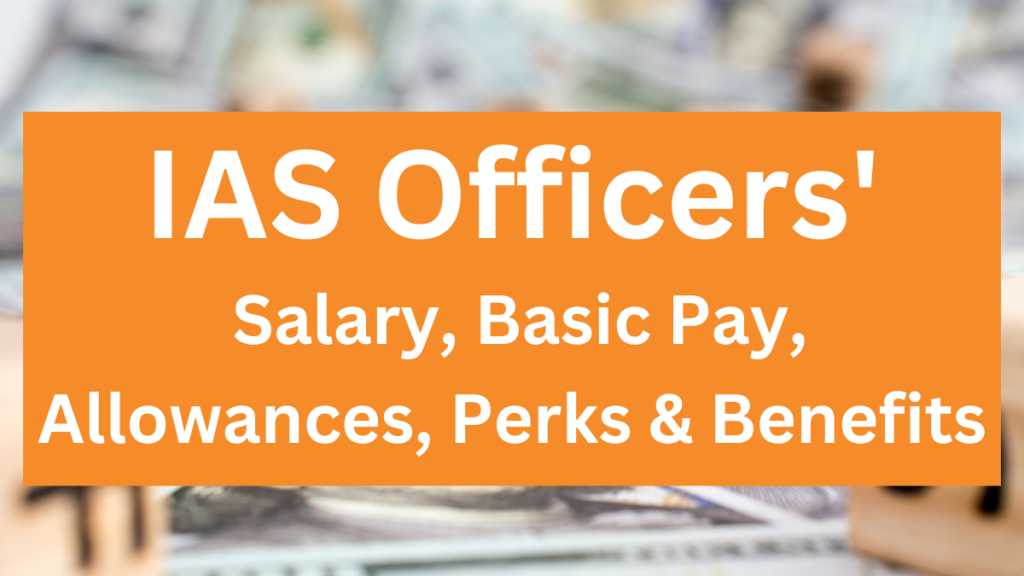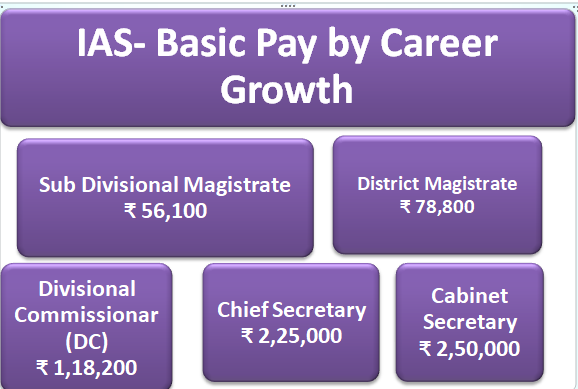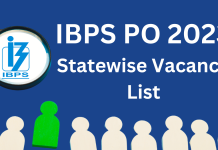In civil service, the age-old adage “With great power, comes great responsibility” resonates deeply, especially for individuals who don the prestigious hat of an IAS officer. In this context, it is fitting to append an additional phrase: “With great responsibility comes a substantial salary package.”
The allure of becoming an IAS officer extends beyond the realm of pride and prestige; it is significantly fueled by the enticing salary, allowances, and other benefits that accompany this esteemed position in public administration. Positioned at the helm of critical roles in the government, IAS officers find themselves at the nexus of public governance. This factor contributes to the popularity of the examination among the youth.
While the life of an IAS officer demands unwavering dedication and hard work, the government ensures that these adept administrators are well-rewarded, with handsome in-hand salary packages and a plethora of allowances. Furthermore, the allure of the IAS profession is heightened by the prospect of increasing remuneration and allowances as officers ascend the administrative hierarchy and secure promotions to high-ranking government posts.

It’s essential to recognize that the substantial compensation afforded to IAS officers is not merely a token of their position but reflects their ability to undertake tasks that few in the Indian workforce can match. This blog delves into the intricacies of the IAS salary structure in 2024, exploring the job profile, allowances, perks, and the promising trajectory of career growth for these pillars of public service. So, without further ado, let’s delve into the fascinating world of IAS salaries and the multifaceted aspects that make this profession truly exceptional.
IAS Officer Salary in 2024
IAS officers in India receive varying salaries based on their rank and years of service, as per the 7th Pay Commission recommendations. The basic IAS salary per month starts at Rs. 56,100 and can go up to Rs. 2,50,000 for the post of Cabinet Secretary of India, the highest-ranking civil servant. The gross monthly salary, which includes various allowances, typically ranges from Rs. 56,000 to Rs. 1,50,000, depending on factors such as location and rank.
The gross monthly salary of an IAS officer comprises components such as Dearness Allowance (DA), Travel Allowance (TA), and House Rent Allowance (HRA). These allowances contribute to the overall compensation, making it more comprehensive. It’s worth noting that the gross salary can vary from state to state and district to district, reflecting the differences in cost of living and other factors.
Overall, the IAS salary structure aims to compensate officers adequately based on their responsibilities and service duration. The salary range reflects the diverse roles and challenges that IAS officers face in different administrative capacities across the country.
| IAS Salary (As per 2024 Latest Notification) | |
| Starting IAS Salary (Monthly Basic Pay) | Rs. 56,100/- |
| Gross Salary (Monthly) | Rs. 56,000 to Rs. 1,50,000 (approx.) |
| IAS Officer Maximum Salary | Rs. 2,50,000/- (Cabinet Secretary) |
| Salary During Training | Rs. 56,100 during 2 year training(Monthly Stipend |
| Allowances | DA, TA & HRA |
| Pay Commission | 7th Pay Commission |
IAS Officer Salary Structure – 7th Pay Commission
As of 2024, an IAS Officer salary structure in India, following the 7th Pay Commission, reflects a nuanced progression based on ranks and years of service. The detailed table outlines the monthly salaries for various posts, demonstrating the evolution of compensation as officers advance in their careers.
Integral to this remuneration are allowances such as Dearness Allowance (DA), Travel Allowance (TA), and House Rent Allowance (HRA), collectively contributing to a comprehensive compensation package. These allowances are essential in adapting the salary to accommodate factors like inflation, travel expenses, and housing costs, ensuring that IAS officers receive a holistic remuneration that aligns with the challenges and demands of their roles.
This salary structure recognizes the dedicated service of IAS officers. It emphasizes fair compensation for the diverse responsibilities associated with different posts, ultimately motivating officers to contribute effectively to public administration.

IAS Officer Grade Pay Scale
The IAS salary in India is organized into eight grades based on work experience, each with distinct grade pay and pay scales. Starting from the Junior Scale with a basic pay of Rs. 56,100, officers progress through the Senior Scale, Junior Administrative Grade, Selection Grade, Deputy Secretary, Director, Principal Secretary, and Chief Secretary, culminating in the highest rank of Cabinet Secretary with a fixed pay scale of Rs. 2,50,000, irrespective of years of service.
- Junior Scale (1-4 years): At the Junior Scale (1-4 years) of IAS service, officers receive a basic pay of Rs. 56,100. In this phase, they may undertake roles like Undersecretary in the State Secretariat, Sub-Divisional Magistrate in District Administration, or Assistant Secretary in the Central Secretariat. This initial level establishes the foundation for their career progression within the IAS hierarchy.
- Senior Scale (5-8 years): In the Senior Scale (5-8 years) of IAS service, officers receive a basic pay of Rs. 67,700. During this period, they may assume responsibilities such as Deputy Secretary in the State Secretariat, Additional District Magistrate in District Administration, or Undersecretary in the Central Secretariat. This phase marks a progression in experience and duties within the IAS hierarchy.
- Junior Administrative Grade (9-12 years): In the Junior Administrative Grade (9-12 years) of IAS service, officers receive a basic pay of Rs. 78,800. During this tenure, they may assume key positions such as Joint Secretary in the State Secretariat, District Magistrate in District Administration, or Deputy Secretary in the Central Secretariat. This stage signifies increased responsibilities and a more significant role in the administrative framework of the IAS.
- Selection Grade (13-16 years): In the IAS service Selection Grade (13-16 years), officers receive an elevated basic pay of Rs. 1,18,500. At this stage, they may take on pivotal roles such as Special Secretary-cum-Director in the State Secretariat, District Magistrate in District Administration, or Director in the Central Secretariat. This phase underscores significant experience and expertise within the IAS hierarchy, accompanied by more substantial administrative responsibilities.
- Deputy Secretary (16-24 years): In the Deputy Secretary phase (16-24 years) of IAS service, officers receive a basic pay of Rs. 1,44,200. In this period, they may undertake crucial roles such as Secretary-cum-Commissioner in the State Secretariat, Divisional Commissioner in District Administration, or Joint Secretary in the Central Secretariat. This stage signifies a higher level of administrative responsibility, reflecting the officer’s extensive experience and expertise within the IAS hierarchy.
- Director (25-30 years): Officers with a basic pay of Rs. 1,82,200 may assume pivotal roles such as Principal Secretary in State Secretariats, overseeing administrative functions, Divisional Commissioner in District Administration, ensuring effective governance at the regional level, or Additional Secretary in Central Secretariats, contributing to policy formulation and implementation at the national level. These positions signify significant responsibilities, reflecting these officers’ diverse and crucial roles in the governmental hierarchy.
- Principal Secretary (30-33 years):In the Principal Secretary phase (30-33 years) of IAS service, officers receive a substantial basic pay of Rs. 2,05,400. At this stage, they may assume pivotal roles such as Additional Chief Secretary in the State Secretariat. Notably, there is no equivalent rank in the District or Central Secretariats, underscoring the heightened level of responsibility and expertise in this position in the IAS hierarchy.
- Chief Secretary (34-36 years): In the Chief Secretary phase (34-36 years) of IAS service, officers receive an elevated basic pay of Rs. 2,25,000. At this stage, they may hold influential roles such as Chief Secretary in the State Secretariat or Secretary in the Central Secretariat. This marks the pinnacle of an IAS officer’s career, reflecting their extensive experience, leadership, and significant contributions to the administrative framework at the highest levels of government.
- 37+ years of service: For officers with over 37 years of distinguished service, the pinnacle of the IAS hierarchy is the prestigious position of Cabinet Secretary of India. This eminent role comes with a fixed and elevated pay scale of Rs. 2,50,000, making it the highest attainable rank in the Indian Administrative Service. The Cabinet Secretary holds a pivotal position at the apex of the bureaucratic structure, overseeing and coordinating key administrative functions at the national level, exemplifying the culmination of an IAS officer’s long and illustrious career.
- Entry Level: In addition to these grades, the entry-level Junior Scale officer receives a pay scale ranging from Rs. 50,000 to 1,50,000 with a grade pay of Rs. 16,500. The progression continues with the Senior Time Scale (after 5 years), and Junior Administrative Grade (after 9 years), and culminates in the highest grade of Cabinet Secretary with a fixed pay scale of Rs. 2,50,000, irrespective of years of service. This tiered structure reflects the evolving responsibilities and experience levels of IAS officers throughout their careers.
IAS Officer Salary in India
The initial overview of IAS salaries in India highlights the basic pay structure without delving into the essential details of additional allowances like House Rent Allowances (HRA), Dearness Allowances (DA), Travel Allowances, and Medical benefits. These allowances are integral components that substantially contribute to an officer’s overall compensation, providing a more comprehensive understanding of the financial aspects of the IAS service. Including these allowances in the salary considerations is essential to grasp the full scope of the remuneration package for IAS officers in India.
These allowances, though variable, play a substantial role in an IAS officer’s monthly income. HRA, influenced by the city of posting, helps cope with accommodation costs. DA safeguards against inflation, ensuring officers maintain their purchasing power. Travel allowances cater to the diverse geographical responsibilities of IAS officers, facilitating the effective discharge of their duties.
For those embarking on UPSC IAS preparation, a robust strategy is essential. Comprehensive approaches, covering a spectrum of subjects, effective time management, and staying abreast of current affairs enhance the likelihood of success in this challenging examination, which remains one of the most prestigious in India. Take a look at this table for further details.
| Years in Service | Basic Pay (INR) | State Secretariat | District Administration | Central Secretariat |
| 1-4 | 56,100 | Undersecretary | Sub-Divisional Magistrate | Assistant Secretary |
| 5-8 | 67,700 | Deputy Secretary | Additional District Magistrate | Undersecretary |
| 9-12 | 78,800 | Joint Secretary | District Magistrate | Deputy Secretary |
| 13-16 | 1,18,500 | Special Secretary/ Director | District Magistrate | Director |
| 16-24 | 1,44,200 | Secretary/ Commissioner | Divisional Commissioner | Joint Secretary |
| 25-30 | 1,82,200 | Principal Secretary | Divisional Commissioner | Additional Secretary |
| 30-33 | 2,05,400 | Additional Chief Secretary | No Equivalent Rank | No Equivalent Rank |
| 34-36 | 2,25,000 | Chief Secretary | No Equivalent Rank | Secretary |
| 37+ years | 2,50,000 | No Equivalent Rank | No Equivalent Rank | Cabinet Secretary of India |
IAS Officer Allowances
Various allowances significantly contribute to an IAS officer’s gross monthly salary. These encompass House Rent Allowance (HRA), Dearness Allowance (DA), Travel Allowance (TA), and more. The gross monthly salary is calculated by adding the basic monthly pay to these allowances. Each allowance serves a specific purpose, from offsetting accommodation costs to addressing inflation and travel expenses. Understanding these components provides a comprehensive view of an IAS officer’s overall compensation structure. Take a look at some of the allowances below:
- House Rent Allowance (HRA): An essential component of an IAS officer’s gross salary, HRA is granted based on the officer’s accommodation needs. In metro cities like Delhi, Mumbai, Kolkata, Chennai, Bangalore, Hyderabad, Ahmedabad, and Pune, the HRA is 24% of the Basic Salary. For smaller cities with a population above 5 lakhs, the HRA is 16%, and for rural postings, it is 8%. If an officer opts for official accommodation, HRA is not applicable.
- Dearness Allowance (DA): Designed to counteract the impact of inflation, DA is a crucial allowance for government employees. After the 7th pay commission, DA started at 0% and now stands at 31%, subject to biannual revisions based on inflation rates.
- Travel Allowance (TA): Credited by the government to cover travel expenses, TA is variable and depends on fuel price fluctuations. TA is not applicable if an IAS officer is provided a government vehicle.
- Other Allowances: Additional allowances include coverage for medical expenses, electricity, water, mobile bills, opportunities for study abroad, pensions, and retirement benefits. These diverse components contribute to the comprehensive compensation package for IAS officers.
IAS Officer: Other Benefits
Besides an attractive salary and various allowances, IAS officers enjoy a range of facilities. This includes allotted residences with minimal to no rent and access to services such as cooks, maids, security guards, and gardeners. Security measures are in place for officers and their families. Subsidies on bills and transportation, subsidized accommodation during official trips, study leaves for pursuing courses, robust job security, and post-retirement opportunities such as appointments to tribunals and commissions contribute to the comprehensive facilities provided to IAS officers.
- Residential Facilities: IAS officers enjoy allocated residences with minimal to no rent, along with access to services like cooks, maids, security guards, and gardeners.
- Security Measures: High-security measures are in place, ensuring officers and their families are protected by security guards.
- Subsidized Bills and Transport: Officers receive substantial subsidies on utilities like water, electricity, gas, and telephone connections. They are also provided vehicles with drivers for official purposes.
- Travel Benefits: IAS officers can access subsidized accommodation in government guest houses during visits to Delhi and state bhavans.
- Study Leaves: Officers are granted official leave for 2-4 years to pursue courses in foreign universities, with the government covering the costs.
- Job Security: IAS officers enjoy robust job security owing to a constitutionally mandated dismissal procedure. This stringent process ensures that any potential dismissal is subject to elaborate investigations as mandated by the Constitution.
- Post-Retirement Opportunities: Upon retirement, IAS officers may be appointed to tribunals, commissions, and consulting companies. Lifetime pensions and other retirement benefits are provided.
IAS Officer Job Profile
The IAS officer Job profile varies from officer to officer depending on the nature of assignments. They can either be assigned a field job at a state secretariat, a public sector undertaking, or a job at the central secretariat. Here is the job profile for an IAS officer.
- Duties and Responsibilities: IAS officers’ job profiles vary, encompassing field assignments, roles in state and central secretariats, and responsibilities in public sector undertakings. Their duties span monitoring the implementation of government schemes, responding to disasters, handling emergencies, and coordinating relief activities during crises.
- Daily Work Routine: IAS officers adhere to a regular daily schedule, commencing their activities at 9:00 AM and concluding by 5:00 PM. This routine involves various tasks, including report creation, department task supervision, field trips, and addressing public concerns.
- District Administrator Role: As district administrators, IAS officers undertake diverse responsibilities such as fund management, administrative affairs handling, collaboration with elected representatives and government departments, and timely response to citizens’ needs and emergencies.
- Career Growth for an IAS Officer: Over time, newly inducted IAS officers experience multifaceted career growth involving diverse postings and promotions. This progression allows them to take on various roles and responsibilities within the administrative framework.
- Training and Induction at LBSNAA: Newly recruited IAS trainees undergo rigorous training at the Lal Bahadur Shastri National Academy of Administration (LBSNAA) in Mussoorie. This comprehensive training covers various aspects of administrative work and provides insights into the intricacies of serving as an IAS officer. Following the completion of training, the recruit formally assumes the role of an IAS officer, initially serving as a Sub-Divisional Magistrate (SDM). This marks the beginning of their practical administrative journey.
Progression Based on Performance: Based on the individual’s performance as an SDM, further responsibilities are assigned, and promotions to higher posts within the administrative hierarchy are granted. This progression is contingent on the officer’s effectiveness and dedication.
Preparation with ixamBee
ixamBee stands as a comprehensive platform catering to the diverse needs of Government job aspirants. Specialized pages for exams like UPSC EPFO (APFC), UPSC EO/AO, and UPSC ESIC EPFO JTO provide targeted resources, aligning with each exam’s specific requirements. BeePedia, a notable feature, is a valuable aid for mastering the current affairs segment, a pivotal aspect of UPSC exams. The platform goes the extra mile by offering Free Mock Tests, Online Courses, and access to Previous Year Papers, ensuring candidates benefit from a holistic and well-rounded preparation experience. With ixamBee, aspirants can adopt a structured approach to their exam preparation. ixamBee stands out as a reliable ally for those navigating the intricate landscape of UPSC examinations, providing the necessary tools and resources for a comprehensive preparation journey.
Summing Up
The life of an IAS officer in India encompasses a prestigious and responsible position in public service, an enticing salary package, and many allowances and facilities. This blog explored the intricacies of the IAS salary structure in 2024, shedding light on the job profile, allowances, and promising career growth trajectory. IAS officers’ evolving responsibilities and experience levels throughout their careers were detailed, providing a comprehensive understanding of the multifaceted aspects that make the IAS profession exceptional. As aspirants embark on UPSC IAS preparation, platforms like ixamBee stand ready to provide comprehensive resources for a successful journey in government examinations.
To help you prepare 50% faster for competitive exams, ixamBee provides a free Mock Test Series and all the Current Affairs in English and Current Affairs in Hindi in the BeePedia capsules for GA Preparation. You can also get the latest updates for Bank PO, Bank Clerk, SSC, RBI Grade B, NABARD, and Other Government Jobs.
Also Read
Everything to Know About the World’s Top Central Banks
How Many Types of Government Job Exams are There?
Everything to Know About the SSC CPO Exam















